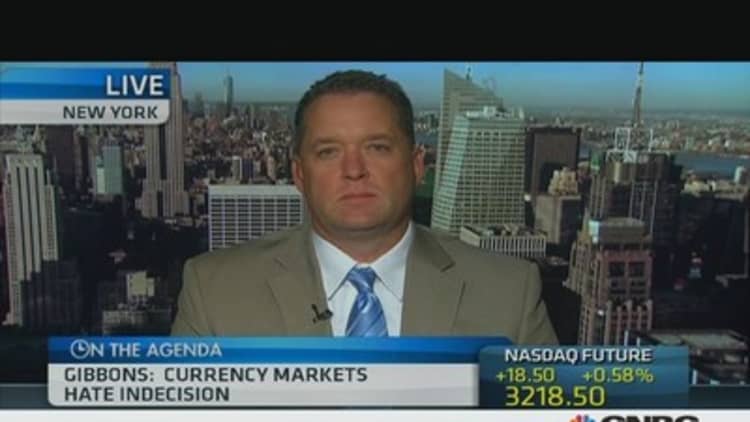At the height of the summer bond market panic over the then-imminent—since-delayed—Federal Reserve taper, Bill Gross took pen to paper and to the airwaves to pitch investors on the enduring nature, and adaptability, of fixed income investing.
In a battle cry letter to Pimco investors that invoked Charles Darwin's theory of natural selection and several war metaphors and references, Gross made his case for moving ahead with bonds in recognition of rising interest rates, and to a larger extent, the end of a long bull market for fixed income.
"All investments, bonds included, have a number of modern-day weapons at their disposal which can be used to defend against higher interest rates," Gross wrote. Indeed, these new bond weapons are proving to be increasingly popular with investors. Which begs the question, just how dangerous are these weapons?
The increase in flows to alternative credit strategies has been notable. At the end of the first quarter of 2013, there was $81 billion in nontraditional bond funds, according to Morningstar. By the end of the second quarter, assets spiked to $95 billion—easily the biggest quarterly growth in the category's history, according to Morningstar's director of fixed-income research, Eric Jacobson. And the record it eclipsed was the $12.6 billion from the quarter previous. In July and August, as investor panic increased over a rising rate environment and the Fed's taper deliberations, the inflows continued at a high level: $7 billion in July and $5 billion in August.
(Read more: Pimco shook hands with the Fed—and made a killing)
"People are absolutely jumping in like gangbusters in the last several months. ... The category went from nothing a few years back to a juggernaut of category," Jacobson said. The growth has been steady over the past few years, but reaching $107 billion in assets by the end of August was an eye-opening mark for a bond fund approach that had just $4.9 billion in assets five years ago.
The move also parallels the rise of alternative equity mutual funds, and both trends have been spurred by a reluctance from even high-net-worth investors to use illiquid alternative strategy funds ever since the crisis when their money was tied up at the worst possible moment.
(Read more: The bond market's ticking time bomb?)
One fund alone—the Pimco Unconstrained Bond Fund, has had inflows of more than $9 billion so far this year, roughly $7 billion more than the fund garnered in all of 2012—a stellar non-risk-adjusted performance run last year helped, said Andrew Clark, research analyst at Lipper.
And the same explosive growth can be seen in funds that don't have the same level of retail investor celebrity as Pimco—TCW's MetWest Unconstrained Bond Fund started the year with $99 million in assets and had reached $437 million in assets by the end of August, a 342 percent growth rate. The strategic income fund category has seen an increase of $6 billion in flows this year, including notable gains for BlackRock Strategic Income, JPMorgan Strategic Income and Goldman Sachs Strategic Income.
This is a huge marketing machine that is being seized on by almost every fund company. They see which way the wind is blowing and everyone wants to be part of it. ... but this many funds coming on this quickly—there are bound to be funds here that won't be best in class.Eric JacobsonDirector of fixed-income research, Morningstar
The barbarians are at the bond fund gates, and investors are opening the gates wide to let them in, and that concerns Jacobson. "The elephant in the room is that the less interest rate risk you take and the more competitive you want to be, the more risk you have to take elsewhere, and a natural place to go is credit risk and credit risk can mean lots of things ... sovereign, emerging markets, currency," Jacobson said.
While Gross used war metaphors, it might be more apt to use a metaphor from the home front, and refer to Gross's new strategic thinking as a "kitchen-sink" approach to bond investing. There's no generally accepted definition of what distinguishes an unconstrained bond fund from a strategic income fund, the marketing names under which these portfolios most commonly are being launched as retail investments. Both types of funds tend to have wide discretion to invest in a multitude of fixed-income securities and derivatives, and both tend to be absolute return-focused and not tied to a traditional benchmark. All of which doesn't only concern Jacobson, but TCW.
(Read more: Best bond plays regardless of the taper)
John Ivanac, director of alternatives marketing for TCW, said the notion of entering a fixed-income bear market, or in the least, a volatile bond market, is responsible for the cropping up of new unconstrained strategies, and while the search for yield is critical, investors do need to apply caution here. "In some respects this has been positioned as a fixed income alternative, and you need to be careful with that," Ivanac said.

Ivanac said as alternative investing concepts make their way into more liquid structures, past mistakes should be front and center. "We are somewhat concerned around what we have seen, and the investor may not get what they are bargaining for. ... Some strategies don't lend themselves to some wrappers," Ivanac said.
He pointed to the breaking of the buck in money market funds during the financial crisis as well as some of the trading inefficiencies in exchange-traded funds, where portfolios can trade at a discount or premium to net asset value. "Lots of managers are retrofitting what they do to fit into a format that's a little tricky," Ivanac said. "It's a good opportunity ... but by same token, we've seen these potential bubbles in the past, and there could be marginal players out there ... new terms being thrown out there like smart beta that might just be doubling up on exposure they have."
As a representative of one of the larger bond fund managers in the U.S., there could be a bit of self-interest in Ivanac's raising of red flags concerning the proliferation of alternative credit strategies, but Morningstar's Jacobson agreed with the TCW official's assessment that size—of bond fund management firm—can be an important factor for investors to consider as more alternative credit strategies are marketed.
"Even if we put aside an argument as to whether a Pimco is a better fund manager than any another, Pimco at least has the breadth of bodies and sector specialists in areas to cover all of these pieces of the market ... when you get to smaller firms relying more and more on pure macro decisions ... it doesn't mean they can't be good, but do I really want them making currency plays if they aren't currency experts?"
(Read more: World's most expensive asset class)
Gross wrote in his recent call to arms, "In a rising interest rate environment over time, a portfolio manager might rely less on maturity 'horses' and depend more on the 'machine guns and flamethrowers' associated with credit, volatility, curve and currency. ... Your reallocations to unconstrained strategies, alternative asset, and even lower duration portfolios are ongoing, and it is those products that predominantly contain non-maturity extension carry. ... Less carry from duration, more carry from credit, volatility, curve and currency in the future years ahead."
Rick Rieder, chief investment officer of fundamental fixed income portfolios at BlackRock, said the defining characteristics of the unconstrained approach could make it seem as if volatility will increase, but it is lower ironically, because the manager can diversify more aggressively.
"Unconstrained means you can use a lot of tools ... the defining aspect of unconstrained is finding where there are opportunities in the world to make a little bit of money lots of the time. ... It's anomalous pricing over short periods of time and that makes it easier to keep volatility down," Rieder said. He added, "The beauty of unconstrained is that we can think about risk cells."
For example, BlackRock can ask questions like: Do we take rate risk in Europe? Will policy be easy there for a while? Will high-yield defaults be low for a while, and new issues increasing in supply? BlackRock can also create distinct liquid and illiquid risk cells, using securities including commercial mortgage-backed securities and collateralized loan obligations. "We still think about managing unconstrained to high return, low volatility and to get efficient beta," Rieder said.
(Read more: The silver-lining in the bond market)
The kind of management freedom inherent in the unconstrained fixed-income approach should give investors pause, though: it's been done before, and didn't work out so well.
"Go back to the late 80s and early 90s and we had bond funds not as broad as these but predicated on the idea that the manager could move in and out of different markets ... take great degrees of freedom and give you the best of everything," Jacobson said.
"I'm skeptical managers can do it any better than they could 10 or 20 years ago. Interest rate betting is really hard and big swings difficult to call," he said, adding that the experimentation with go-anywhere bond fund management ultimately led managers back to a benchmark-centric, institutional methodology of being more conservative and focused.
There are currently 62 mutual funds categorized as nontraditional bond by Morningstar—not a large asset class for an industry offering more than 7,500 funds—but in the new bond normal, there are likely more to come. "This is a huge marketing machine that is being seized on by almost every fund company," Jacobson said. "They see which way the wind is blowing and everyone wants to be part of it. ... The good news is that there are teams out there that do have the expertise to do it, but this many funds coming on this quickly—there are bound to be funds here that won't be best in class."
—By Eric Rosenbaum, CNBC.com.





